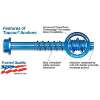I recently bought a new (to me) home and moved my gun safe to the basement. (Actually, I hired several younger and stronger men to move it, but that's not really important to this story.)
The safe claims to be waterproof up to about 18 inches of flooding, as long as it is properly bolted to the floor (at least in terms of the manufacturer's warranty). At my old house, I bolted it to the concrete floor using your standard expansion wedge anchor. This "works" in the sense that it makes it difficult to scoot the safe across the floor, but if someone successfully applied some crowbar leverage to knock over the safe, its weight would simply pull the wedges right out of their holes.
So my question is, what type of concrete anchor do you use to fasten your safe to the concrete floor in the basement?
The safe claims to be waterproof up to about 18 inches of flooding, as long as it is properly bolted to the floor (at least in terms of the manufacturer's warranty). At my old house, I bolted it to the concrete floor using your standard expansion wedge anchor. This "works" in the sense that it makes it difficult to scoot the safe across the floor, but if someone successfully applied some crowbar leverage to knock over the safe, its weight would simply pull the wedges right out of their holes.
So my question is, what type of concrete anchor do you use to fasten your safe to the concrete floor in the basement?


